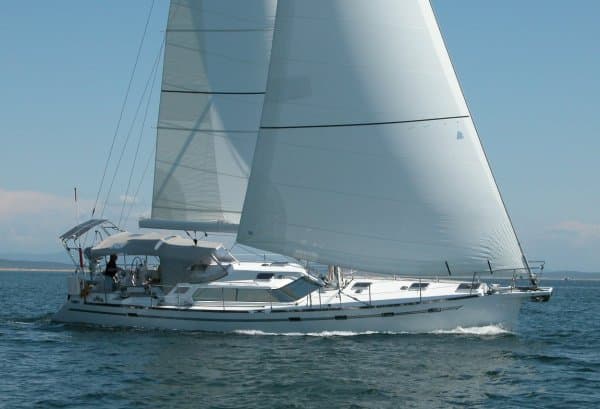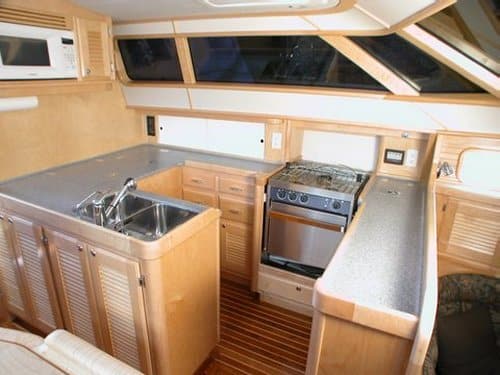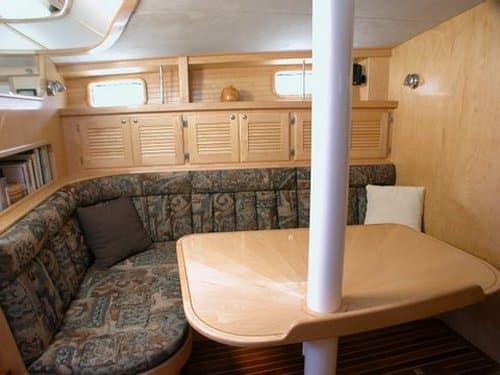
In the language of the Pacific Northwest’s First Peoples, the word skookum (pronounced as it’s spelled, with the accent on the first syllable) can mean, depending on the context, strong, big, good, powerful, or beautiful. All those definitions describe the steel-hulled Isolabella, an Ed Rutherford-designed Waterline 50 built on a semicustom basis in Sidney, British Columbia.
Holly Knight and her husband, Jeff Frost, used to cruise their Jeanneau 45 all over the Northwest, but they found that the boat was limited for winter cruising. It’s in winter that they find they have some of the most beautiful harbors in the world all to themselves; those same harbors are jam-packed during the summer. When they saw Rutherford’s Waterline 50 Mettle at the Seattle Boat Show in 2006, they knew they’d found the right boat for their cruising style, and in December 2007, they left Sidney aboard a Waterline 50 of their own, homeward bound for Olympia, Washington.
I met them on a misty summer morning during a layover at Sidney’s Van Isle Marina, where they had Isolabella tied up. They were on their way back to Olympia after a monthlong cruise as far north as Desolation Sound. As I climbed the steps up the tall topsides from the floating dock, I caught a whiff of cranberry scones that Holly had just pulled from the oven, making me wish I’d had a couple of sausages fewer for my breakfast. I ducked under the dodger and made my way closer to the goodies below.
The vertical surfaces and trim in Isolabella’s interior are lustrous cherry, and the sole is satin-finished maple planks with narrow teak strips between them; it’s the opposite of the traditional teak-and-holly sole, and it creates a very pleasing effect. Four Lewmar hatches and an opening port provide plenty of ventilation for the living area. To port of the companionway in the raised pilothouse, the U-shaped galley is larger than the kitchen in many a New York apartment. Holly is an enthusiastic and talented baker; she searched for and eventually found the Broadwater stove, a four-burner propane model made in Australia. “It was hard to get, but it’s the only stove I’ve found with an oven that keeps consistent temperature,” she says. “That’s key for baking.” It’s gimbaled and all the way outboard in the galley; the double sink is opposite, close to the centerline. Huge pilothouse windows provide the chef with a 270-degree view, and there’s good access to the cockpit for conversation, emergencies, or scone passing. The green Corian-topped countertops seemed just a little out of proportion until Jeff told me that since he and Holly are both tall, they’d insisted that the counters be six inches higher than normal so they wouldn’t be bending over to wash dishes or cook on the stove top. Not that I actually washed a dish, mind you, but I found that the galley was very comfortable to use for me at six feet tall, demonstrating the benefits of having a boat built to one’s own specifications.
Opposite the galley and a step up is seating forward and aft of a dinette table. A spectacular view through the pilothouse windows greets the crew from both seats. This is the couple’s cool-weather hangout. Its inviting comfort nearly persuaded me to spend the day there. But, as the television commercial says, that ain’t all: At the forward-facing seat, one can press a button and from the center of the table a pod slowly rises containing Raymarine instrumentation, including a screen that combines radar, chart plotter, and display from a video camera that’s mounted on the mast. In inclement weather, a Raymarine autopilot allows the boat to be steered from here while the skipper keeps an eye on the screen for the ubiquitous floating logs, deadheads, and kelp that make cruising in the Pacific Northwest a challenge. Engine controls and a VHF radio sit unobtrusively out of the way of loungers in a cubby by the navigator’s right hand.
Jeff says the pod was hard to design and execute, and it took some persuading to get the builders behind the idea, but now all future boats from the company will have this feature available.

There’s room for four to eat and hang out at the table with the pod down, and since Holly and Jeff don’t fill Isolabella with a crowd, they decided to replace the large dining table to port in the main saloon (a few steps down and forward) with a cushioned ottoman for sybaritic lounging. A settee opposite can double as a berth and rounds out the area. Musician Jeff keeps a guitar strapped to the bulkhead just forward of the mast.
Forward of the saloon is a large guest cabin with its own head and separate shower. The comfortable double berth lies well aft of the bow, thanks to deck storage and chain lockers forward of the watertight crash bulkhead that forms the front of the cabin.
The master cabin is aft of the pilothouse, a few steps down to starboard. Entering it, to starboard is a seven-foot-tall heated hanging locker for the drysuits that the pair use when they indulge in another pastime, scuba diving. A large island double sits on centerline, with a nice-sized head and shower combination forward to port.
Beneath the sole in the pilothouse lurks the 160-horsepower Yanmar diesel that drives a conventional propeller shaft. There’s good access to the systems in the well-lit and immaculate engine room.
Tanks for 200 gallons of water are on either side of the keel sump; in the keel itself, 250 gallons of diesel adds to the stability of the boat. Eighteen inches of external lead ballast is fixed to the bottom of the keel; the tight turn of the bilge adds form stability.
The topsides curve slightly, which adds strength to the structure and prevents the hull plating from getting bowed in between the frames by waves, as we so often see on slab-sided hard-chine boats and big ships. It also increases the aesthetic appeal of the Waterline boats.
Rutherford, who sold Waterline Yachts to Maarten Kooijman and Mark Teisson in 2005, says that performance has always been one of his goals in designing boats. On the 50, he kept the bow fairly plumb, to increase waterline length, and the entry a little fuller than on some boats, to increase reserve buoyancy, because, he says, “Owners are going to put two anchors on the bow and attach 600 feet of chain. That weighs a lot, and we don’t want the bow burying in a seaway.”

Overall, Rutherford makes a huge effort to keep the boats relatively light so they sail well. “It’s easy to overbuild metal boats,” he says. “We’re careful to avoid that, but these are still stronger than any plastic boat.” One way Waterline avoids building in extra weight is to make sure that the structure is fair, eliminating the need for gallons of fairing compound. Closely spaced longitudinal stringers and frames support the hull plating, which measures 3/16 inch thick on the topsides and 1/4 inch below the waterline. The keel is made from 3/8-inch material. When I saw the new 57-footer under construction in Waterline’s shop near the airport in Sidney, I was impressed by just how fair they’d managed to keep the raw, unpainted hull.
That being said, Rutherford concedes that steel isn’t a material from which to build lightweight flyers, and given all the furniture and toys that a typical Waterline Yacht carries, sail area is the boat’s friend. A full-battened UK Halsey Tape Drive main unrolls from a Leisure Furl boom, and a 120-percent Tape Drive genoa rolls up on a Harken furler. The sails are hung on a masthead rig from Yachttech Spars and Rigging that towers 78 feet above the water.
Lewmar electric winches handle the genoa sheets, genoa furling, and the main halyard and furler. The primaries are located an easy stretch from the helm seats near the twin wheels.
The cockpit is well laid out with a large overhanging canvas dodger that’s perfect for keeping the weather off the crew as they stretch out on the long, straight seats. The wheels locate the helmsman well outboard to provide a good view of the sails and around the pilothouse. This allows for a wide passage between them to the high, gated stern rail. When they’re sailing, a 12-foot RIB hangs from davits here, and on cruises, a couple of crab pots are lashed to the pushpit but ready for quick deployment to catch dinner in some still anchorage. A couple of steps down the stern is where on many boats you’d find something called a swim platform, but on this boat, designed for the cold waters of the Pacific Northwest, there’s a dock, instead, that’s the perfect height for boarding the dinghy.
Underfoot, the deck is covered with Flexiteek, a synthetic teak look-alike that’s glued over the painted steel. Clear, wide side decks encourage crewmembers to venture forward of the mast.
Holly and Jeff maintain an apartment in Redmond, Washington, near where she’s a program manager at Microsoft. They also have a house in Olympia that they’re slowly finishing while Jeff takes care of his real-estate development projects. They spend as much time as possible on the boat and cruise year-round. The pair has a solid sailing background, and Jeff showed he was a man after my own heart when he maneuvered Isolabella from her tight slip at Van Isle Marina, eschewing use of the bow thruster. That was my first hint that this big steel boat was more than just a floating condo.
When I put the boat through her paces under power, I liked what I found. She motored smoothly and quietly, hitting an easy eight knots at 2,200 rpm. With the engine in reverse, she stopped in surprisingly good time. I put the boat beam on to the 12-knot breeze in the smooth water of Tsehum Harbour, stopped her, and backed down, first with the wind on the port side, then to starboard, expecting the windage from the furled genny to make the bow blow to leeward. I was pleasantly surprised that it didn’t-another hint of good things to come once the sails were set. The big skeg-hung rudder provided excellent control.
Off the Sidney waterfront, we set the sails with the push of a button or two and put Isolabella on the breeze. The Lewmar/Whitlock steering system gave me good rudder feedback as the boat accelerated on a closehauled course. The 12-knot breeze was enough to give the boat about five knots of boat speed-not bad for a big, heavy boat.
When the breeze picked up to 15 knots, Isolabella showed that she’ll be capable of fast passages when she gets offshore. Holly and Jeff plan to spend more time on the boat as they get closer to retirement. Alaska is in their sights, then perhaps a cruise through the Panama Canal and up to Maine before looking for more territory to explore. “We’ve been told not to bother with Hawai’i,” says Holly. “But we definitely want to see Australia’s Great Barrier Reef.”
They were discussing names for their new boat in an Italian restaurant when Holly and Jeff caught sight of a poster for a Mediterranean seaside spot, Isola Bella, which translates loosely into “beautiful island.” From that, the boat’s name jumped out at them, and it certainly describes this skookum, go-anywhere yacht.
Andrew Burton is CW’s associate editor.








